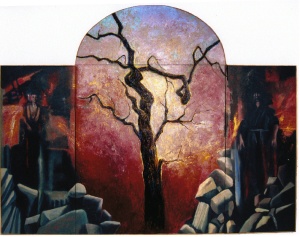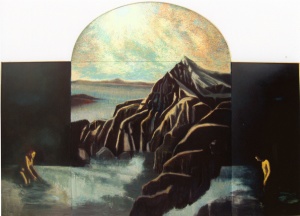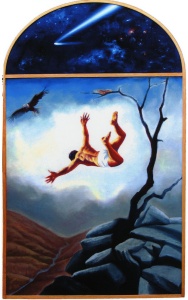New Paintings
“When the Holy One, blessed is He, created the first man, He took him and led him around the trees of the Garden of Eden and said; ”Look at my works! See how beautiful they are–how excellent! For your sake I created them all. See to it that you do not spoil and destroy my world, for if you do, there is no one to repair it after you…” (Koheles Rabba on verse 7:13). Creator and created became partners in creation, sharing responsibility. Janet Shafner takes a long hard look at this mutual responsibility and how it connects us back to the Garden of Eden in her new series of paintings, The Divine Ecology.
In the first act of disobedience man soiled Paradise and brought death into the world, paradoxically giving life its ultimate value. And just as life became precious, so did the very volition that could remove it, free will became the foundation of human existence. In the Divine act of choice, God chose the Jews and redeemed us from the shackles of Egyptian slavery so that we could freely choose to serve Him. The glory of the Jews is our freedom; we can choose to serve God and maintain His world or rebel and ravage His creation. Our history and that of our co-occupants on this planet has been discouraging at best.

The Tree of The Knowledge of Good and Evil / Hiroshima Maidens (2003) establishes Shafner’s insistence on the timeless nature of the Torah. She depicts the Primal Tree, in the center barren and twisted, sprouting from an angry crimson rubble. The bark and some branches are still burning. The side panels of this triptych utilizes images from the Hiroshima Peace Museum that show the aftermath of the nuclear bombing Japan. Ghostly shattered figures emerging from the burning rubble are slowly understood as a kind of twisted echo of Adam and Eve. Steam and smoke hisses from the fallen architecture evoking not only Hiroshima but the World Trade Center.
On August 6, 1945 some 70,000 men, women and children perished in the first nuclear bombing. Another 70,000 died soon after. The image of the Hiroshima Maidens forms a complex metaphor for our awesome power of choice between good and evil. The Hiroshima Maidens refers to an attempt on the part of some Americans to repair the terrible damage we had wrought. In 1955 twenty-five Japanese women who survived the bombing of Hiroshima were brought to New York Mount Sinai Hospital for reconstructive surgery to remedy the blast’s disfigurement. Hosted by local New York Quakers their stay here was plagued by constant attention of the press and, in an effort to raise the necessary funds, an appearance on “This is Your Life.” In perhaps one of the most bizarre twists of this strange tale, the “Mystery Guest” was the co-pilot of the Enola Gay, Captain Robert Lewis. The agony of victims who survived is reflected in the twisted forms of the tree. We begin to realize that human choice is frequently tragically flawed and yet is constantly necessary to maintain our world.
Deeping the metaphor, The Tree of Life (2003) is seen as entangled with the Tree of Knowledge of Good and Evil to make them existentially dependent upon each other. In their unity they give birth to a visual representation of a burst of “cellular life.” The interdependence of knowledge (implying choice) with the breath of life itself affirms the Jewish belief that the essence of life is spirituality rooted in worldly action. Shafner’s choice of this motif attempts to move the primeval story of creation out of the cosmic and into the mundane. Her pictorial contrast of interlocked branches, earth reds juxtaposed with blackened limbs, are framed by two fiery pods of painted energy that seem deeply rooted in an abstract mythological symbolism.

In stark contrast The Four Rivers (2004) brings the mythological firmly into a contemporary reality by means of narration. The barren otherworldly landscape forms a primal source for water, water that is not only literally life-giving but that acts as a spiritual link to the lost Eden. Quoting the Pirkei de Rabbi Eliezer (20: 47b) Shafner reminds us that Adam consoled himself after his expulsion from the Garden by touching the waters of the four rivers that flowed out of the Garden. Their source was beneath the Tree of Life and they flowed out to all four corners of the world. Shafner depicts a man on one side and a woman on the other using the water as a mikveh that offers, as “living waters,” connection with the original source of life. This painting makes a leap through the millennia reminding us of not only the need for ritual purity but also the ecological purity of the waters we so carelessly pollute and defile. She insists here that this is no mere symbolic connection, rather our responsibility is in the here and now.
The last painting in the series, The End of Paradise (2004), reverts to a mythological vision, depicting “the flame of the ever-turning sword” as a barrier against the Tree of Life. The floating image of a whitish yellow ellipse surrounded by conflagration of red and yellow fiery static exists in a pictorial void, forever warning an absent audience not to approach the forbidden goal of life eternal.
Shafner’s Divine Ecology vacillates between a sharp narrative edge and images that lull the eye into a mythological stasis of the organic world. This tension between narrative and symbol seems central to her understanding of the Torah’s purpose. While I’m not sure this dialogue is entirely fruitful it certainly makes one aware of some of the different ways the Torah can be seen, especially in the early passages of Genesis that seem so distant and in fact, mythological. It seems to me that her genius is in bringing a narrative, discursive and critical perspective to exactly this material that is so removed from our everyday life.

Janet Shafner invokes a Talmudic perspective to her many paintings of the Torah, juxtaposing texts and contemporary images to reawaken meanings long dormant. Another recent painting, Compassion for the Mother Bird / Out of the Whirlwind (2003), plumbs the issues of reward and punishment as they clash with God’s justice and our finite understanding. Divine Ecology challenged us with our responsibility as guardians of God’s creation; here she explores the boundaries of our knowledge and understanding. The main panel depicts the “age-old enigma of why the good suffer,” depicting a young man fatally falling (or diving) from a tree after fulfilling the mitzvah of sending the mother bird away. The classic Talmudic text (Kiddushin 39b) relates the story of a son who obediently obeys his father and chases the mother bird away before retrieving a chick from the nest. In the midst of performing two mitzvot whose reward is long life (obedience to parents and sending the mother bird away) death overtakes the faithful lad. The Gemara struggles with explanations but is clearly unsettled with the incomprehensible stark reality. Shafner crowns her painting with a cosmic vision (again a contrast between narrative and symbolic) that alludes to the verse in Job that reminds us “that mortal man cannot comprehend the mind of the Creator: ‘Then Hashem responded to Job from out of the whirlwind, saying: …Where were you when I laid the foundations for the earth? Pray tell – if you are so wise! …When all the morning stars sang in unison, when all the angels shouted… Have you ever ordered up the morning, told the dawn its place?'” (Job 39:1-12).
This remarkable painting returns us to the Divine Ecology series, challenging us in our Divine partnership. We must do our part; maintain God’s creation, carefully exercise our choices between good and evil and, after all is said and done, hope for the best. As stewards of our world we have awesome responsibility and yet tragically limited power. We simply cannot know God’s ways and must finally accept his judgments. It is in the acceptance of His will, frequently incomprehensible, that our true freedom rests. As in the startling image of Shafner’s last painting, the falling figure, clearly contemporary, is welcoming his fall, indeed soaring in acceptance of the Divine will. This is the final challenge of faith that Shafner’s paintings dare us to match.
Janet Shafner
860 442 2449; [email protected]